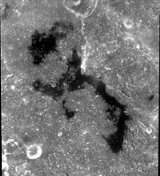
Lacus Autumni
Encyclopedia
Lacus Autumni is a region of lunar mare
that lies near the western limb of the Moon
. Along this side of the lunar surface is a huge impact basin centered on the Mare Orientale
. Two concentric mountain rings surround the Orientale mare, the inner ring being named Montes Rook
and an outer ring called the Montes Cordillera
. Lacus Autumni lies in the northeastern quadrant of the gap between these two mountain rings. Unfortunately this section of the lunar surface is difficult to observe directly from the Earth
.
This mare has selenographic coordinates of 9.9° S, 83.9° W, and it lies within a diameter of 183 km. (Compare to the Mare Orientale, which has a diameter of 327 km.) This mare runs from the southeast to the northwest, reaching a maximum width of 90-100 km. Only the central and southeastern sections of the lake have regions of relatively low albedo
material typical of a lunar mare. The remainder matches the albedo of the surrounding terrain.
Lunar mare
The lunar maria are large, dark, basaltic plains on Earth's Moon, formed by ancient volcanic eruptions. They were dubbed maria, Latin for "seas", by early astronomers who mistook them for actual seas. They are less reflective than the "highlands" as a result of their iron-rich compositions, and...
that lies near the western limb of the Moon
Moon
The Moon is Earth's only known natural satellite,There are a number of near-Earth asteroids including 3753 Cruithne that are co-orbital with Earth: their orbits bring them close to Earth for periods of time but then alter in the long term . These are quasi-satellites and not true moons. For more...
. Along this side of the lunar surface is a huge impact basin centered on the Mare Orientale
Mare Orientale
Mare Orientale is one of the most striking large scale lunar features, resembling a target ring bull's-eye. Located on the extreme western edge of the lunar nearside, this impact basin is difficult to see from an Earthbound perspective.Material from this basin was not sampled by the Apollo program...
. Two concentric mountain rings surround the Orientale mare, the inner ring being named Montes Rook
Montes Rook
Montes Rook is a ring-shaped mountain range that lies along the western limb of the Moon, crossing over to the far side. It completely encircles the Mare Orientale, and forms part of a massive impact basin feature...
and an outer ring called the Montes Cordillera
Montes Cordillera
Montes Cordillera is a mountain range on the Moon. This feature forms the outer wall of peaks that surround the Mare Orientale impact basin, the inner ring being formed by the Montes Rook...
. Lacus Autumni lies in the northeastern quadrant of the gap between these two mountain rings. Unfortunately this section of the lunar surface is difficult to observe directly from the Earth
Earth
Earth is the third planet from the Sun, and the densest and fifth-largest of the eight planets in the Solar System. It is also the largest of the Solar System's four terrestrial planets...
.
This mare has selenographic coordinates of 9.9° S, 83.9° W, and it lies within a diameter of 183 km. (Compare to the Mare Orientale, which has a diameter of 327 km.) This mare runs from the southeast to the northwest, reaching a maximum width of 90-100 km. Only the central and southeastern sections of the lake have regions of relatively low albedo
Albedo
Albedo , or reflection coefficient, is the diffuse reflectivity or reflecting power of a surface. It is defined as the ratio of reflected radiation from the surface to incident radiation upon it...
material typical of a lunar mare. The remainder matches the albedo of the surrounding terrain.

